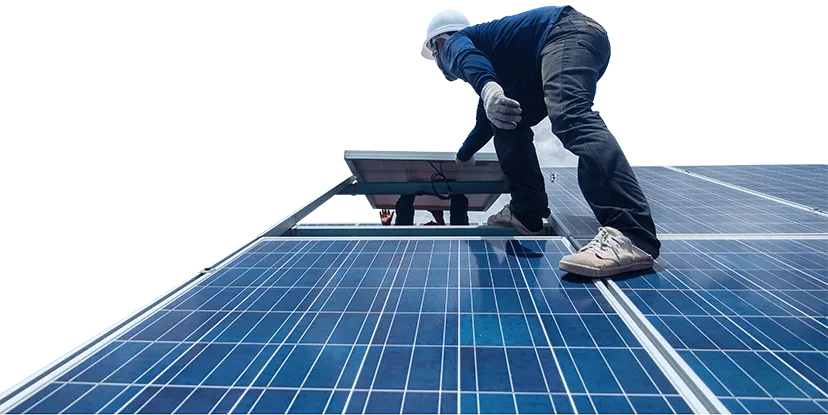Household solar panel
Household solar panel system is a renewable energy solution designed to harness the sun’s energy to generate electricity for residential use. This system typically consists of solar panels, an inverter, and other components that work together to convert sunlight into usable electricity to power your home. By utilizing solar energy, households can reduce reliance on traditional power grids, lower electricity bills, and contribute to a more sustainable environment.
Key Components of a Household Solar Panel System:
- Solar Panels (Photovoltaic Panels):
These are the core components that capture sunlight and convert it into electricity. Solar panels are typically made of semiconductor materials like silicon that produce electrical current when exposed to sunlight.
Panels are usually installed on the roof or other sun-exposed areas of a home.
Solar panels vary in efficiency, size, and cost. The most common types are monocrystalline, polycrystalline, and thin-film panels.
- Inverter:
The inverter converts the direct current (DC) electricity produced by the solar panels into alternating current (AC), which is the form of electricity used by most household appliances.
There are different types of inverters:
String Inverters: A central inverter that converts DC from multiple panels.
Microinverters: Small inverters installed on each panel, allowing for individual optimization.
Power Optimizers: These work with string inverters to optimize the performance of each panel.
- Mounting System:
This includes the hardware used to secure the solar panels to the roof or the ground. The system is designed to withstand environmental conditions like wind and rain.
- Electrical Meter:
A net meter is often installed to track the amount of energy your solar system produces and the amount you consume from the grid. If your solar panels produce more electricity than you use, the excess can be sent back to the grid, and you may receive credits or compensation from your utility company (depending on local regulations).
- Battery Storage (Optional):
A battery storage system allows you to store excess electricity generated during the day to use at night or during cloudy days when solar production is low.
Batteries can help homeowners become more independent from the grid and increase energy savings.
Benefits of Household Solar Panels:
- Lower Electricity Bills:
Solar panels allow homeowners to generate their own electricity, which reduces the amount of power purchased from the utility company. This can lead to significant savings on monthly electricity bills.
- Environmental Impact:
Solar power is a clean, renewable source of energy. By using solar energy, households can reduce their carbon footprint and contribute to the fight against climate change by decreasing greenhouse gas emissions.
- Energy Independence:
Solar panels provide an opportunity for homeowners to reduce their dependence on the grid, offering greater energy security, especially in areas with unreliable or expensive electricity supply.
- Increased Home Value:
Homes with solar panel systems often see an increase in value. Potential buyers may be attracted to the idea of reduced energy costs and the environmental benefits of solar energy.
- Government Incentives and Rebates:
Many governments offer incentives, tax credits, or rebates for installing solar panels. These incentives help reduce the upfront cost of the system, making it more affordable for homeowners.
- Low Maintenance:
Solar panels are generally low-maintenance systems. They typically require cleaning a few times a year to remove dust and debris and should be inspected periodically to ensure they are functioning optimally.
Factors to Consider When Installing Household Solar Panels:
- Location and Roof Condition:
The effectiveness of solar panels depends largely on the location and roof orientation. Solar panels work best when installed on a south-facing roof in areas with abundant sunlight. A professional installer can help determine the best placement based on your specific situation.
- Energy Consumption:
To determine how many panels you need, it’s important to understand your household’s energy consumption. The system should be sized to meet your daily electricity needs, which may vary seasonally.
- Upfront Costs and Financing:
The initial cost of a solar panel system can be substantial, but there are various financing options available, including loans, leases, and power purchase agreements (PPAs). Additionally, many regions offer incentives that can offset some of the costs.
- System Size and Efficiency:
The number of panels required for your household depends on factors like your energy consumption, the efficiency of the panels, and the amount of sunlight your home receives. More efficient panels may cost more upfront but require fewer panels to meet your energy needs.
- Installation and Permitting:
Solar panel installation requires permits and approval from local authorities. It’s essential to work with a certified installer who understands local regulations and can handle the paperwork for you.
- Long-Term Investment:
Solar panels typically have a lifespan of 25 to 30 years. Over time, the energy savings from a solar system can pay back the initial investment, making it a long-term financial benefity thinking on behalf of our clients every day, we anticipate what they want, ineed and build lasting relationships.



